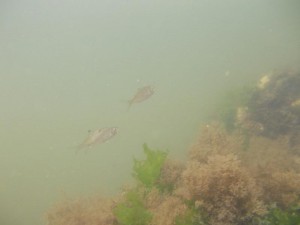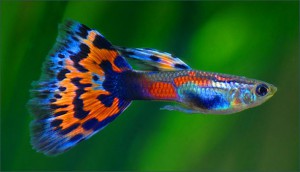Environmental pollution has become one of the biggest concern to the human race. Ironically, although we suffer from pollution, we are also the biggest contributor to pollution. Pollution not only affects human health but also poses a major threat to the quality of surrounding natural resources and the quality of life of other animals. While we figure out ways to minimize pollution, one can’t help but to wonder, how well are animals adapting to the human-induced rapid environmental change (HIREC)? Well, one study by Ehlman et al. suggests that a species of guppies may have found visual and behavioral ways to better adjust to turbid water.

Turbid water decrease quality of visual information (source: http://lh6.googleusercontent.com/–7Nzcpw5AXQ/UT3jl_9xqlI/AAAAAAAACKs/TX9YAN6BqMk/s800/DSCN0062.JPG)
In turbid water, the visual information that animals are able to gather deteriorates. This negatively affects guppies as they heavily rely on sight to detect approaching predators. However, all is not lost as previous studies have found that some organisms may be able to compensate via developmental plasticity. In their study, Ehlman et al. examined the developmental plasticity of behavior and color vision in response to turbidity in the Trinidadian guppy (Poecilia reticulate) and found some interesting, if not impressive, results.

Trinidadian guppy (Poecilia reticulate) (source: https://s-media-cache-ak0.pinimg.com/736x/27/9f/dc/279fdc31a8b8ee328d5f6eea823eafad.jpg)
This study investigated if the guppy’s developmental experience in clear or turbid water can affect its behavior when exposed to turbid water as an adult and how exposure to turbid water affects responses to an olfactory predator cue. First, they placed baby guppies in one of two developmental treatments: clear or turbid water. Once they reach sexual maturity, the guppies were then put through a series of two behavioral trials. One trial was in clear water and the other in turbid water and these trials were in randomized order. The experimenters measured the fish’s activity in the tank for 10 minutes. Then, a chemical substance emitted by a natural guppy predator, the pike cichlid (Crenicichla frenata) was injected into the tank and the guppy’s behavior was measured for 10 more minutes. The chemical substance, kairamone, is added to simulate the presence of a predator. On top of that, the experimenters also quantified opsins, which are light-sensitive protein found in retinal cells that play a role in color vision and motion detection, in the guppies.
This study found that the fish that were reared in clear water showed a trend towards decreased activity in turbid water as adults compared to in clear water, whereas fish raised in turbid water trended towards increased activity in turbid water. Moreover, in response to predator exposure, all fish, regardless of developmental treatments and trial conditions, decreased activity. However, the guppies that were reared in turbid water showed more activity than those reared in clear water.
Now, what could possibly be an advantage of increasing activity in turbid water? One possible explanation is that increased activity enables the guppies to maintain encounter rates with prey and thus improving their foraging abilities. The increased activity of guppies that were raised in turbid water raised in turbid water during the predation trial may represent a reduced perceived risk as turbidity may decrease predation by offering a refuge from predators. This study is the first to show that adult fish behavior can be affected by development in turbid water.
In addition, this study also found that in guppies that were reared in turbid water, there was an increase in expression of longer wavelength-sensitive opsins. Previous literature (Shaerer and Neumeyer, 1996; Krauss and Neumeyer 2003) has shown that long-wavelength opsins is important in motion detection. Thus, this suggests that the guppies raised in turbid water compensate by improving their ability to detect motion via increased expression of longer wavelength-sensitive and thus this aids them in both prey and predator detection.
All in all, there are a couple of major takeaways from this paper. One, fish living in turbid water may be better cope by increasing activity and restructuring their visual system. This is significant as it highlights the importance of developmental plasticity in response to rapidly changing environments. Two, not only can human activity strongly affect the quality of natural resources, but it can also affect the life history and phenotypic traits of animals. Thus, it’s high time we get our act together and reduce pollution. Let’s not wait until it is too late.
References
Ehlman S. M., Sandkam, B. A., Breden, F., Sih, A. (2016) Developmental plasticity in vision and behaviour may help guppies overcome increased turbidity
Krauss A, Neumeyer C (2003) Wavelength dependence of the optomotor response in zebrafish (Danio rerio). Vision Res 43:1275–1284.
Schaerer S, Neumeyer C (1996) Motion detection in goldfish investigated with the optomotor response is “color blind”. Vision Res 36: 4025–4034.
